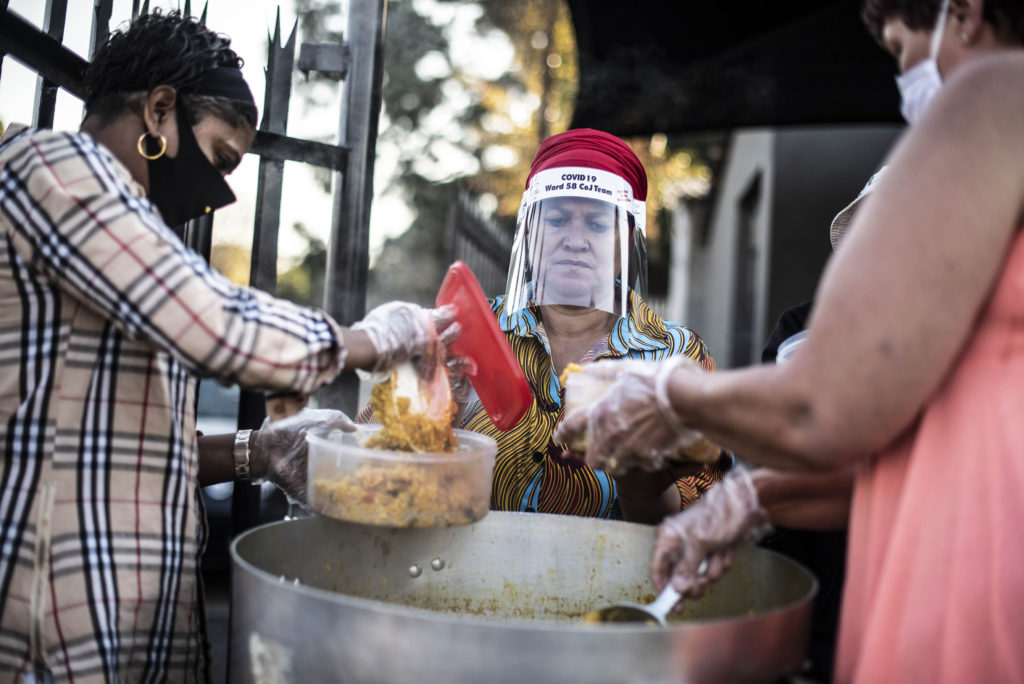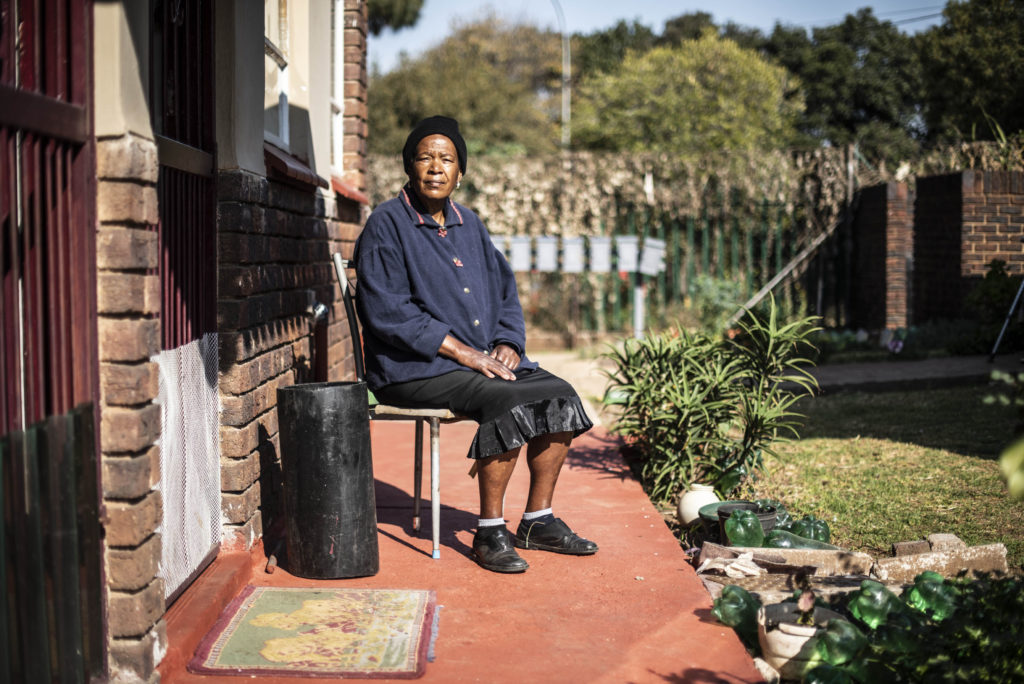Confronting death: Jackie Mofokeng in her room at the Caroline Street old-age home, looking out over the Brixton cemetery. (Paul Botes)
Jackie Mofokeng has a grim view from the Caroline Street old-age home. Brixton cemetery is both a reminder of nearness of death and — as a refuge for the homeless, who sleep among its headstones — of poverty and neglect in Johannesburg’s inner city. The old-age units at Caroline Street are among the 258 in Jan Hofmeyer, the Johannesburg suburb established in 1935 to provide council housing for working-class white people.
Towards the end of May, as South Africa prepared to move to level three of the lockdown, a Covid-19 case was identified at Teak Court, an all-male old-age tenement. The building was quarantined, its gates locked with a chain, and only reopened on Monday, 14 days later.
News of the case sent tremors through Jan Hofmeyer. The small suburb forms part of Johannesburg’s ward 58, where Covid-19 cases have more than doubled in recent weeks.
For some people the easing of the lockdown was something to celebrate, as it promised relief from the economic pinch that has afflicted the area’s mostly poor residents. But for the elderly of Jan Hofmeyer, it is a source of fear.
‘I’m scared‘
Mofokeng’s mask slips below her nose when she talks. The 69-year-old says now that more people are moving around, she is constantly on edge. Like others, she has confined herself to the old-age home, leaving only to get the hot food served by local philanthropist Yola Minnaar, and to collect her pension. “I am scared. I am scared to take a taxi because I don’t know what is going to happen to me on the way. I am scared.”
 Philanthropist Yola Minnaar serves hot food to hungry people living in the Fietas area. (Paul Botes)
Philanthropist Yola Minnaar serves hot food to hungry people living in the Fietas area. (Paul Botes)
Daphne Sehota, who lives in a complex at the other end of Jan Hofmeyer, was sick the week the lockdown was announced. “My throat hurt. I was hot,” the 68-year-old recalls, sitting on the edge of a couch in Minnaar’s home. A neighbour came past to greet me. I said: ‘No, rather you don’t come near me, because I think I have this disease. Call the ambulance.’ And she did so. The ambulance came quick. And when they came, I saw people climbing out who looked like astronauts.”
Sehota tested negative for the virus. But she says every time there is a screening at the complex, she will “run to go see if I have it or if I don’t”. This vigilance is justified. The elderly are at a significantly greater risk of complications from Covid-19 and fatality rates have been shown to increase with age.
According to the World Health Organisation, more than 95% Covid-19 fatalities in Europe have been of people 60 years or older. In May, it was reported that 35% of Covid-19 deaths in the United States were among nursing home populations.
In South Africa, 57% of Covid-19-related deaths have been among people between the ages of 60 and 99. According to Statistics South Africa, the country has the largest population of older people in Africa. In addition, about 40% of South Africa’s old people are poor, leaving many dependent on the precarious public healthcare system.
In Jan Hofmeyer, the vulnerability of older people collides with the abject poverty of many other residents. Minnaar, who runs a feeding scheme out of her home, says panic about the lockdown’s economic effects has far outweighed the fear of the virus itself.
‘I can’t turn them away’
On Monday afternoon, when the Mail & Guardian visited the complex, a line of physically distanced Jan Hofmeyer residents snakes round the corner as Minnaar piles vegetable akhni into lunch boxes. The steam from the giant metal pot threatens to mist her perspex visor. She ushers the older people to the front of the queue. “The old people — it’s like looking at my mother and my father. You know the aunties and the uncles.
It’s like parents,” Minnaar says. She stands in the near-barren lot opposite her house. “There [are] a lot of needy people in our area … And there’s a lot of people who come to me for help. I can’t turn them away. It’s young and old. But there’s a lot of old people in our area.”
At 3pm, when the serving begins, some walk by the line on their way home from the jobs they have finally returned to. Workers in blue overalls pile out of a bakkie and pause to rest in the lot — one-third playground, two-thirds nothing at all.
Unemployment has driven many people in the area to hunger, especially during the lockdown. “It’s sad to see so many people that’s hungry. There’s a lot of people that’s hungry,” Minnaar says, clasping her hands to her chest.
“How many people go to bed without food? Because there’s times when they will send me a message asking for something to eat and I have to give them out of my own fridge.” Efforts to curb the spread of the coronavirus have triggered a global unemployment crisis, with informal sector workers — about 20% of South Africa’s workforce — hardest hit. Early in the crisis, the International Labour Organisation warned the coronavirus outbreak would have a devastating effect on global “working poverty”. The working poor live close to or below the poverty line.
Working-class communities around the world have felt the brunt of the virus. In the United Kingdom a report by the Offi ce for National Statistics noted that people living in more deprived areas “have experienced Covid-19 mortality rates more than double those living in less deprived areas. General mortality rates are normally higher in more deprived areas, but so far Covid-19 appears to be taking them higher still.” According to an analysis by the Association for Neighborhood and Housing Development, in New York, the communities that have experienced the highest rates of infections also have the largest number of service workers, rent-burdened households and people of colour.
In the last week of May, Johannesburg’s Ward 58 — the group of suburbs that hug the inner city, stretching from Jan Hofmeyer to Crosby — went from having 40 cases to 98, the sharpest increase in Gauteng. Residents of Jan Hofmeyer refer to the suburb as Fietas, the name given to nearby Pageview, which was rezoned under the Group Areas Act and declared “white”.
The area has been systematically “greyed”. According to the 2011 census, Jan Hofmeyer is now less than 30% white, and white people now make up less than 10% of the population in the greater ward 58.
In 2011, 40% of the people living in the ward were economically inactive — 1.4 times the rate of the rest of Gauteng. Many of the older people living in Jan Hofmeyer moved to the suburb only after being allocated spaces in the old-age units. As a result, they have been cut off from their families during the lockdown.
‘Remove this virus’
“Covid-19 has been stressful. It has been a difficult time for us. Our relatives can’t visit us. We can’t visit our relatives … It’s not a good time,”
Helena Rathopo says from behind a mask that covers most of her face. She sews masks for the other women in the Caroline Street complex.
 Helena Rathopo, who also lives in the Caroline Street complex, misses going to church. (Paul Botes)
Helena Rathopo, who also lives in the Caroline Street complex, misses going to church. (Paul Botes)
Rathopo also struggles with being torn from her spiritual life at church. She says when she is alone, she prays for “God to help us to remove this virus”. Maria Tiny Molepo (74) fears that if she catches the virus and dies, her family will not be able to attend her funeral. The thought preoccupies her. “We don’t go anywhere. We can’t see our kids and nobody can come to see us.”
Her body slightly turned towards the cemetery, Molepo says the loneliness of the lockdown “hurts”.
It also hurts that those living around the complex seemingly disregard the threat the virus poses to the old people. “They don’t care. We’re scared that they are going to come and bring it to us … They are up and down outside, up and down. We don’t know what they are doing outside. They can bring it to us,” she says, trying to muzzle the melody coming from her old phone.
Molepo says her children still need her. “Their father is dead for a long time. If I’m dying, then they have no father and no mother. And my grandchildren, they like me. They want to come see me. But they can’t. They can’t.”
Winnie Afrika’s brassy voice disrupts Molepo’s line of thought: “But we are here to die.” Reluctantly, Molepo agrees. “Yes. We’re here to die. This is the last place we are living. We are living here until we die.”